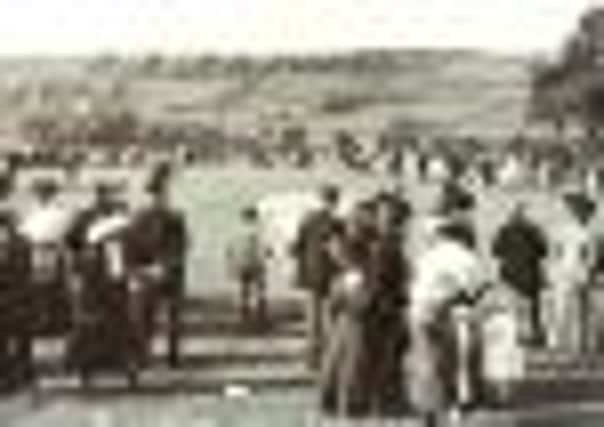Memories of a farming fixture


It added that the chief aim was to “promote the betterment of the breeding stock locally, and during the dreary winter months to arrange for a course of discussions on matters appertaining to the farming industry”.
Remarkably, it took just five weeks to organise the first event, held at Timble, on Saturday, September 15. There were numerous competitions for different livestocks as well as traditional skills like sheep shearing, and the local paper was able to report that “good humour and jocularity prevailed everywhere”.
Advertisement
Hide AdAdvertisement
Hide AdThe show went on to become an annual fixture and with the increasing use of cars, lorries and coaches, farmers and visitors from a wide area of Yorkshire made it a regular day out each September. The show also spawned twice-yearly sheep sales at a couple of local inns.
But by the late 1960s, the show was struggling with financial losses, and on May 7 1975, the decision was taken to wind it up altogether, although the sheep sales managed to continue until the mid-1980s.
The Washburn Valley runs to the north of Wharfedale, and in the 19th century was used by the Leeds Waterworks Company for the construction of a chain of four huge reservoirs – Thruscross, Fewston, Swinsty and Lindley Wood.
Today, many of the same families which organised and took part in the Washburn Show a century ago, continue to farm along the valley.
Advertisement
Hide AdAdvertisement
Hide AdWhile farmers and villagers still have memories of the show’s halcyon days, it was decided to stage an exhibition celebrating its history, making use of trophies won by grandparents and great-grandparents, scrapbooks of newspaper cuttings, boxes of fading photographs and memorabilia like winners’ trophies and rosettes.
Says Stephen Ryder, the local parish council chair: “There was such a treasure-trove of material, we just had to recall the show and the sheep sales for people who love the valley today, whether they be people who’ve spent all their lives here or those who have moved to the valley comparatively recently.”
But at an early meeting to discuss the exhibition, a pile of catalogues from the shows held back progress when farmers flicked through the pages and kept saying to one another things like, “Well, my dad beat your dad in that class”.
As news of the proposed exhibition spread through the valley, more families got in touch to offer material. Eventually, the show’s history began to emerge from scrapbooks, catalogues and a book of minutes recording show committee meetings.
Advertisement
Hide AdAdvertisement
Hide AdAfter the first event at Timble it moved to Norwood, then to other sites at Fewston and Blubberhouses. Two annual sheep sales were also held, first at the Hopper Lane Hotel, on the A59 Harrogate-Skipton road, then at the isolated Sun Inn, above Fewston.
One of the most interesting stories unearthed relates to the Mudd family of Thornthwaite, who developed a national reputation for their butter-making.
They won more than 1,000 prizes at shows around the UK, and became famous for making flowers out of butter, using milk from different breeds of cow to obtain lighter or deeper shades of yellow.
On display at the exhibition are old photos of the Mudd family’s butter creations, as well as a butter churn and butter pats.
Advertisement
Hide AdAdvertisement
Hide AdLike many agricultural shows, the Washburn was not held during the years of the Second World War, but through the 1950s and the early 1960s, increased car ownership saw it become very popular. Records show that judges came from well outside the area: places as far apart as Lancaster, Hawes, Richmond and Brighouse.
But in the late 1960s, the show’s popularity began to wane, and Stephen Ryder is in no doubt as to why it got into financial difficulties.
“There were two reasons,” he says. “One was VAT, which had just been introduced. Although the rate at that time was only 10 per cent, it made balancing the books a bit of a struggle.
“The other killer cost was the hire of marquees. The minute books show that three or four of them were required, including big ones for refreshments and produce competitions for eggs, bread and teacakes, handicrafts, preserves, flowers and that sort of thing.”
Advertisement
Hide AdAdvertisement
Hide AdThe show may have ended almost 40 years ago, but mementos from it still crop up in sales rooms, antique shops and even at some of today’s agricultural shows. At this year’s Otley Show, for example, the farmer who won the Champion Dalesbred prize found that he was presented with a trophy which, for many years, was the prize at the Washburn Show.
The exhibition is the first major event at the new Washburn Heritage Centre, which has been sunk into a grass bank adjoining the 17th-century Fewston Church. Built with £630,000 of grants from the Heritage Lottery Fund and LEADER rural development aid, plus local fund-raising of £60,000 and footpath links and signs provided by Yorkshire Water, the centre’s role is to serve as a focal point for scattered Washburn communities and to interpret the valley and its history for visitors.
Sally Robinson, chair of Washburn Heritage, says it is hoped the centre will draw more people to the area. A programme of displays and events are planned for when the Washburn Show exhibition ends in two months’ time.
The exhibition on the Washburn Valley Show and Sheep Sales runs until late July, open Saturdays and Sundays 11am-4.30pm at the Washburn Valley Heritage Centre, St Michael and St Lawrence Church, Fewston, HG3 1SU.